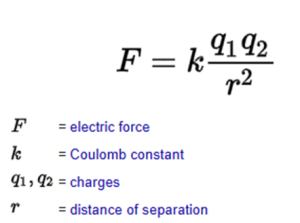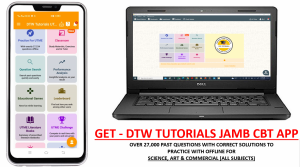17.0 ELECTRIC CURRENT
Electric current refers to the flow of electricity in an electronic circuit, and to the amount of electricity flowing through a circuit. It is represented by ‘I’ and measured in Ampere (A).
METHODS OF PRODUCTION OF ELECTRIC CHARGE
- By Friction: When two different materials are rubbed together, electrons may transfer from one material to another, resulting in one body becoming positively charged and the other negatively charged.
- By Contact: When a charged body touches a neutral body, electrons can transfer, causing the neutral body to become charged.
- By Induction: A charged body can induce a charge in a neutral body without direct contact. The neutral body becomes polarized, and if grounded, it can gain a net charge.
ELECTROSCOPE: An electroscope is a device used to detect electric charge.
COULOMB’S LAW: It states that the force (F) between two-point charges (q1 and q2) is directly proportional to the product of the charges and inversely proportional to the square of the distance (r) between them.

ELECTRIC FIELD (E): The electric field is defined as the force per unit charge experienced by a positive test charge placed in the field E = F/q
ELECTRIC POTENTIAL (V): The electric potential at a point in an electric field is the work done in bringing a unit positive charge from infinity to that point.
V = W/q
FIELD INTENSITY (E): It is a vector quantity that represents the force experienced by a unit positive charge in an electric field.
POTENTIAL (V): It is a scalar quantity that indicates the potential energy per unit charge at a point in the field.
POTENTIAL DIFFERENCE (ΔV): The difference in electric potential between two points in an electric field, which is the work done to move a charge between those points.
17.1 CAPACITORS
A capacitor is an electronic component that stores electrical energy in an electric field. It consists of two conductive plates separated by an insulating material called a dielectric.
BASIC STRUCTURE OF A CAPACITOR
- Plates: Conductive materials (often metal) that store charge.
- Dielectric: An insulating material between the plates that increases the capacitor’s ability to store charge.
PLATE CAPACITORS: A parallel plate capacitor consists of two conductive plates separated by an insulating material (dielectric).
The capacitance of a parallel plate capacitor is determined by the area (A) of the plates, the distance (d) between them, and the dielectric constant (ε) of the material between the plates.
FUNCTIONS OF CAPACITORS
- They Store electrical energy for later use.
- They Smooth out fluctuations in the power supply (filtering).
- They Block direct current (DC) while allowing alternating current (AC) to pass.
PARALLEL CAPACITANCE (C): It is defined as the amount of charge (Q) stored per unit voltage (V) across the capacitor:
C = Q/V (measured in Farads (F))
Where 1 Farad = 1 Coulomb/Volt.
RELATIONSHIP BETWEEN CAPACITANCE, AREA, SEPARATION OF PLATES, AND MEDIUM
The capacitance of a parallel plate capacitor can be expressed as:
C = ε * (A/d)
Where C =Capacitance,
ε = Permittivity of the dielectric material,
A = Area of one of the plates,
d = Separation between the plates.
CAPACITORS IN SERIES AND PARALLEL
- Capacitors in Series: The total capacitance (CTotal) is given by:
1/CTotal = 1/C₁ + 1/C₂ + 1/C₃… + 1/Cn
The charge (Q) is the same across all capacitors, but the voltage divides.
- Capacitors in Parallel: The total capacitance (CTotal) is given by:
CTotal = C₁ + C₂ + C₃ … + Cn
The voltage (V) is the same across all capacitors, but the charge divides.
ENERGY STORED IN A CAPACITOR: The energy (U) stored in a capacitor is given by the formula:
U = (½)CV²
Where: U = Energy stored,
C = Capacitance,
V = Voltage across the capacitor.
17.2 ELECTRIC CELL
Electric cell is a device that converts chemical energy into electrical energy through electrochemical reactions.
KEY COMPONENTS OF AN ELECTRIC CELL
- Anode: The electrode where oxidation occurs (loss of electrons).
- Cathode: The electrode where reduction occurs (gain of electrons).
- Electrolyte: A substance (usually a liquid or gel) that contains ions and conducts electricity, allowing the movement of charge between the electrodes.
TYPES OF ELECTRIC CELLS
- Voltaic (Galvanic) Cells: Generate electricity from spontaneous chemical reactions (e.g., batteries).
- Electrolytic Cells: Use electrical energy to drive non-spontaneous chemical reactions (e.g., electrolysis).
17.3 SECONDARY CELLS
Secondary cells, also known as rechargeable batteries, can undergo reversible chemical reactions, allowing them to be recharged and used multiple times.
TYPES OF SECONDARY CELLS
- Lead-Acid Accumulator: Used in vehicles; consists of lead dioxide (positive plate) and sponge lead (negative plate) in sulfuric acid(H²SO⁴) , Rechargeable and provides high current.
- Nickel-Iron (NiFe) Cell: Uses nickel oxide and iron as electrodes in an alkaline electrolyte, known for durability and long life.
- Lithium-Ion Cell: Common in portable electronics; uses lithium compounds as electrodes, high energy density and lightweight.
17.4 PRIMARY CELLS
Primary cells are electrochemical cells that generate electricity through irreversible chemical reactions. Once the reactants are used up, the cell cannot be recharged.
TYPES OF PRIMARY CELLS
- Daniel Cell: A type of voltaic cell consisting of a copper sulphate solution and a zinc electrode. The reaction involves zinc oxidizing and copper ions reducing, generating electricity.
- Leclanché Cell
- Wet Leclanché Cell: Contains a zinc anode, carbon cathode, and ammonium chloride solution as electrolyte.
- Dry Leclanché Cell: A variation where the electrolyte is in a paste form, making it portable and leak-proof.
17.5 TYPES OF ARRANGEMENT OF CELL
- Series Arrangement: Cells are connected end-to-end, increasing the total voltage while the current remains the same.
Total Voltage = V₁ + V₂ + V₃ + …
- Parallel Arrangement: Cells are connected side-by-side, increasing the total current while the voltage remains the same.
Total Current = I₁ + I₂ + I₃ + …
DTW Tutorials Study Resource Links;
First of All to obtain high JAMB &WAEC Scores, YOU HAVE TO Practice! Practice!! Practice!!
Use DTW JAMB & WAEC 2025 CBT Practice App!!!
– GET DTW TUTORIALS JAMB & WAEC 2025 CBT EXAM PRACTICE APP for all Subjects with over 31,000 Past Questions and Correct Solutions to Practice with offline! (Activation cost is N4000 for 1 year) Download Links Below for Mobile Phones & Laptop Computer;
DTW TUTORIALS JAMB 2025 APP For MOBILE Phone Direct Download link;
https://play.google.com/store/apps/details?id=com.iafsawii.dtw.jamb
DTW TUTORIALS JAMB 2025 APP For DESKTOP Laptop Computer Direct Download link; https://drive.google.com/file/d/1iIHBoWjEeJeCFyTO9nt-9kAveH2FqjrT/view?usp=sharing
Download Links for WAEC 2025 App;

JAMB RESOURCE LINKS BELOW;
– JAMB Past Questions Solved Playlists on Math, Phy, Chem; https://www.youtube.com/playlist?list=PLLgYU6fS5143-p4dfWIFL7keuB1SBgT2b
– THE LEKKI HEADMASTER – Summary, Questions And Answers (JAMB 2025 NOVEL); https://dtwtutorials.com/the-lekki-headmaster-jamb-2025-novel-summary-questions-and-answers-pdf-download/
– JAMB 2025 Recommended Text Books – https://dtwtutorials.com/jamb-2025-recommended-text-books-for-all-subjects/
– JAMB 2025 Syllabus all Subjects – https://dtwtutorials.com/jamb-2025-syllabus-free-download/
– JAMB 2025 Syllabus in 30 Days Timetable Challenge by DTW Tutorials for Science, Art & Commercial Subject Combinations – Cover Your JAMB Syllabus in 30 Days Challenge; https://dtwtutorials.com/jamb-2025-syllabus-in-30-days-timetable-challenge-by-dtw-tutorials-cover-your-jamb-syllabus-in-30-days-challenge/
– How to Manage Your Jamb Exam Time for High Scores; https://youtu.be/Tp4Va8haib8
– Physics Notes and Questions on All topics; https://dtwtutorials.com/category/tutorials/physics-tutorials/
– Chemistry Notes and Questions on All topics; https://dtwtutorials.com/category/tutorials/chemistry/
– How to Read, Understand and Remember Always- https://youtu.be/kL8BpRePudA
– How to Cover Your JAMB Syllabus Fast in 30 Days!!; https://youtu.be/RVgyn01Ptd0
– What to do a night before your Jamb Exam (+Exam Prayers); https://youtu.be/njbAx4Oz5Rw
– How to Manage Your Jamb Exam Time for High Scores; https://youtu.be/Tp4Va8haib8
– Overcoming Exam Fear/Anxiety– https://youtu.be/Uvf81rvd0ls
You can also join our online groups below for instant JAMB 2025 Updates;
Join DTW JAMB 2025 Intensive Tutorials Study Groups on Facebook, Telegram and WhatsApp Group;
Facebook Group – https://web.facebook.com/groups/dtwtutorialsgroup/
WhatsApp Group – https://chat.whatsapp.com/E8pprCQYtahKfpQN9UB0aU
Telegram Group – https://t.me/+AcXfhJPSIiI2ZTY0
WhatsApp Channel – https://whatsapp.com/channel/0029VaAWvTmDDmFT9o25dV3u
DTW JAMB 2025 Intensive Online Lessons/Tutorials
Online JAMB 2025 Tutorials – Your Path to Jamb Success!
Are you preparing for the JAMB 2025 Exam and aiming for excellence? Look no further than Online Jamb Tutorial by DTW Consult. We’re dedicated to helping you ace your Jamb with confidence.
- Why Choose DTW Online JAMB Intensive Tutorials?
• Engaging, Clear and Interactive Online Lectures
• Completion of JAMB Syllabus
• Weekly Quiz Assessments
• Continuous Brainstorming and Competitions
• Membership in an Active Learning Community
• Consistent Solving of JAMB Past Questions-
• Expert Jamb Instructors
• Comprehensive Study Materials - All Classes are Recorded!! In case you miss any class, and when you join us you will have access to all the previous class recorded videos!!!
• Subjects;
English
Physics
Chemistry
Biology
Math
Economics
Literature
Crs
Government
• Affordable Tuition – N7000 monthly (6pm – 10pm, Mon to Fri)
Lectures Ongoing! Register Now!!
Bank Details:
Account Name: DTW Consult
Account Number: 6414330770
Bank: Moniepoint
Amount – N7000
For easy payment and enrollment.
Proof of payment should be sent by WhatsApp.
Contact Us:
WhatsApp: 09085099582, 08038732879
Email: dtwconsultng@gmail.com
Take a step closer to your Jamb success with DTW Online Jamb 2025 Intensive Tutorials.
Let’s work together to unlock your full potential!

https://youtu.be/P7wtBH46ZMMnsive Tutorials. Let’s work together to unlock your full potential! #JambPrep #OnlineTutorial #DTWConsult #JambSuccess #jamb2025 #utme2025

No Comments